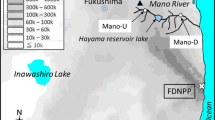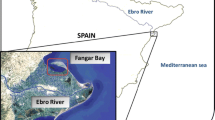Abstract
ALTHOUGH marine organisms have been strongly implicated in the biogeochemical cycle of plutonium, there is disagreement as to whether they can assimilate it efficiently1–7. We have examined the fate of plutonium in a single, worm-crab food chain after ingestion of the isotope which had been metabolically incorporated into the predator's food. Contrary to absorption efficiencies of tenths to hundredths of 1 % derived from studies with vertebrates8–10, our results show that relatively large fractions of plutonium are readily absorbed from ingested food and incorporated into the predator's tissues.
Similar content being viewed by others
References
Volchok, H. L. et al. in Assessing Potential Ocean Pollutants, 27–63 (National Academy of Sciences, Washington, DC, 1975).
Schell, W. R. & Walters, P. L. Hlth Phys. 29, 589–597 (1975).
Wahlgren, M. A., Alberts, J. J., Nelson, D. M. & Orlandini, K. A. in Transuranium Nuclides in the Environment, STI/PUB/410, 9–24 (International Atomic Energy Agency, Vienna, 1976).
Noshkin, V. E., Bowen, V. T., Wong, K. M. & Burke, J. C. in Proc. third natn. Symp. Radioecol., CONF-710501-P2, 681–688 (USAEC, Oak Ridge, 1971).
Fowler, S. W., Heyraud, M. & Beasley, T. M. in Impacts of Nuclear Releases into the Aquatic Environment, STI/PUB/406, 157–177 (International Atomic Energy Agency, Vienna, 1975).
Bowen, V. T., Livingston, H. D. & Burke, J. C. in Transuranium Nuclides in the Environment, STI/PUB/410, 107–120 (International Atomic Energy Agency, Vienna, 1976).
Pillai, K. C. & Mathew, E. in Transuranium Nuclides in the Environment, STI/PUB/410, 24–45 (International Atomic Energy Agency, Vienna, 1976).
International Commission on Radiological Protection, Publication No. 19 (Pergamon, Oxford, 1972).
Durbin, P. W. Hlth Phys. 29, 495–510 (1975).
Bair, W. J. & Thompson, R. C. Science 183, 715–722 (1974).
Moghissi, A. A. & Carter, M. W. Hlth Phys. 28, 825–826 (1975).
Richmond, C. R. LA-2207, 1–139 (Los Alamos Scientific Laboratory, 1958).
Odum, E. P. & Golley, F. B. in Radioecology Proc. first natn., Symp. Radioecol. (eds. Schultz, V. & Klement, A. W.) 403–410 (Reinhold, New York 1963).
Hubbell, S. P., Sikora, A. & Paris, O. H. Hlth Phys. 11, 1485–1501 (1965).
Reichle, D. E. Ecology 48, 351–366 (1967).
Bryan, G. W. J. mar. biol. Ass. UK 48, 303–321 (1968).
Heyraud, M., Fowler, S. W., Beasley, T. M. & Cherry, R. D. Mar. Biol. 34, 127–136 (1976).
Guary, J. C., Masson, M. & Fraizier, A. Mar. Biol. 36, 13–17 (1976).
Ward, E. E. Nature 209, 625–626 (1966).
Workshop on Environmental Research for Transuranic Elements, ERDA-76/134, 1–62 (Energy Research and Development Administration, Washington DC, 1975).
Author information
Authors and Affiliations
Rights and permissions
About this article
Cite this article
FOWLER, S., GUARY, JC. High absorption efficiency for ingested plutonium in crabs. Nature 266, 827–828 (1977). https://doi.org/10.1038/266827a0
Received:
Accepted:
Issue Date:
DOI: https://doi.org/10.1038/266827a0
- Springer Nature Limited
This article is cited by
-
Experimental study on vanadium transfer in the benthic fish Gobius minutus
Marine Biology (1992)
-
Americium biokinetics in benthic organisms as a function of feeding mode
Bulletin of Environmental Contamination and Toxicology (1985)
-
Biokinetics of plutonium, americium and californium in the marine isopod Cirolana borealis, with observations on its feeding and molting behavior
Marine Biology (1985)
-
Assimilation, inter-organ transfer and excretion of americium in two teleost fish
Marine Biology (1983)
-
Tissue and subcellular distribution of 252Cf and 241Am in the seastar Marthasterias glacialis
Marine Biology (1983)





